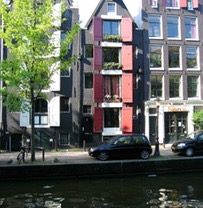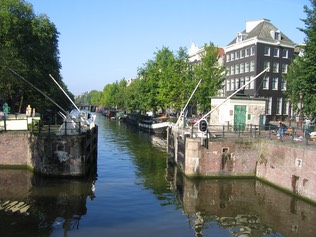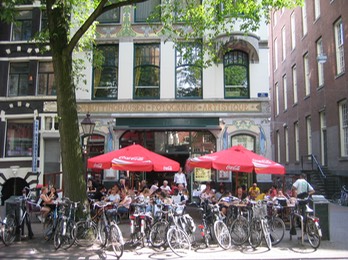Published in RIAS ‘Quarterly’ 2011-01-07

SHIFTING SANDS
Ian Stuart Campbell FSAI HonFRIAS
Unique places evolve sometimes by reasons of architecture; geography; history, or people. Amsterdam is unique in so many ways, that it almost defies analysis. There are so many anomalies to consider that each visitor to the ‘Dam, will quickly build their own intimate understanding of this unique city and its ‘horse shoe’ grid plan.
From a 12th century village, Amsterdam became the world’s richest city trading in agriculture, and diamonds, with the first ever Stock Exchange opening in 1602. The architecture reflected its prosperity in fine residences for merchants, financiers, craftsmen, doctors, lawyers, politicians and artists.
Lack of space along new canal quays, forced houses to be built tall and narrow, characterized by high windows, decorative gables, steep internal stairs and a pulley outside to transport larger objects to upper floors. Often these residences also served as businesses with storage in attics and cellars.

Today Amsterdam manages to be at once, both lush and leafy (boasting more trees than Paris) yet with barely a patch of ‘green’ ground big enough to comfort a puppy. Tall gently leaning trees line canals, growing miraculously in sand below hard paved walkways.
Sand is also the base beneath the distinctive herringbone paving, the bollards, the street furniture, and even the buildings. The jaunty angles, which readily appear, even on newly set bollards, and rakish reinforced gables, belie the fact that this urban fabric has resisted collapse for over 400 years. It appears as a complex dynamic balance where interlocking forces mutually support each other.
Logic and the parable of the two builders (Matthew 7), suggests that cities should not be constructed on sand. Certainly they should not be built 13 feet below sea level. Yet somehow Amsterdam has survived the Industrial Revolution; two World Wars, and vibration from cars, heavy lorries and rumbling trams. An ambitious underground Metro plan, is however currently threatening this historic equilibrium. Thus far only excavations for the stations have progressed, but contract delays, vastly increased construction costs, and now settlement on some adjacent properties may jeopardise the project.

Civic determination to maintain ‘quality of life’ accolades for Amsterdam lies behind significant investment in other recent civic projects such as: ARTIS, Aquarium and Zoo buildings; new facilities at Vondelpark; Nemo, science and tech museum; Van Gogh Museum, Stedelijk Museum, and the Rijksmuseum; the new music hall at Muziekgebouw; and the huge new Central Library beside Central Station. All these bare witness to social priorities, which aim to improve quality of life for all residents.
No cultural initiative however has had less impact on the building fabric, and more effect on the appearance of the city than the Dutch adoption of bicycles. Basic upright grandparent cycles, ‘opafiets’ are used by all ages, shapes, and genders. Heavy machines, with back pedal braking, are adapted with handle bar seats for children, or as a ‘bakfiets’, extended with a box for 2 more kids, livestock, or groceries.
Municipal support now provides that all parts of the city are accessible and safely linked by dedicated bike routes. Vigorously regulated ‘Cyclist Priority’ ensures caution from drivers of thrusting 4X4’s, while each urgent ‘ping’ scatters pedestrians on all minor roads and junctions. Truly every cyclist has a “Golden Seat” from which to appreciate Amsterdam.
[534 words]